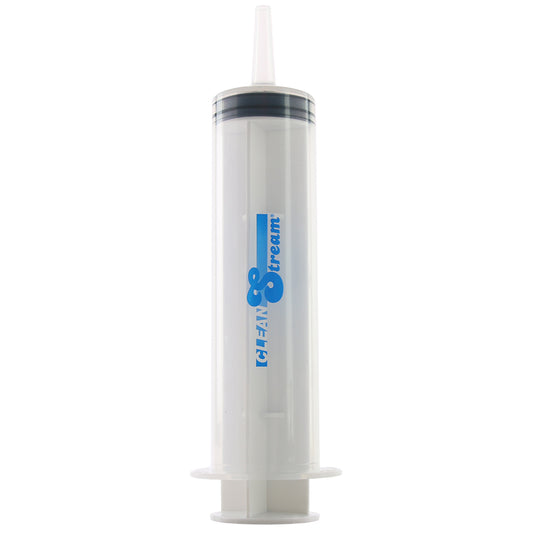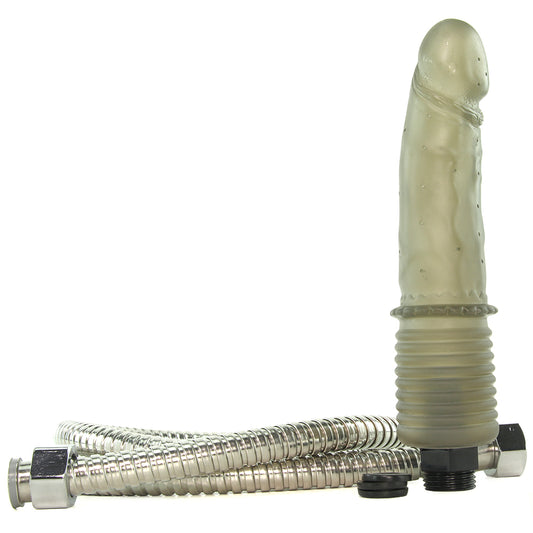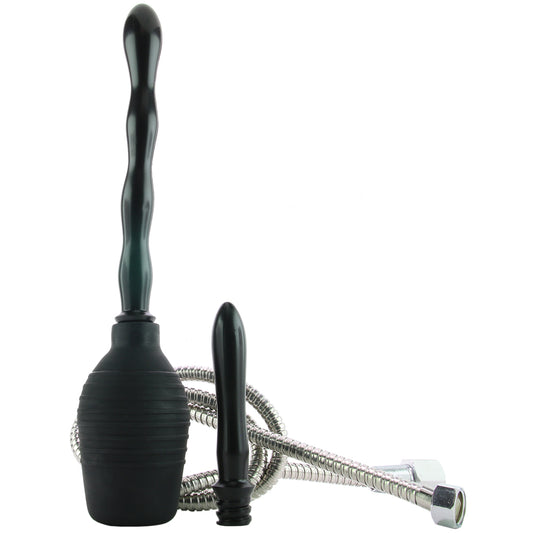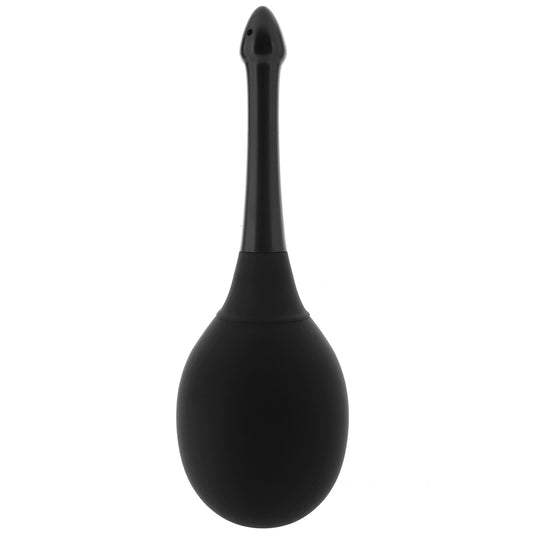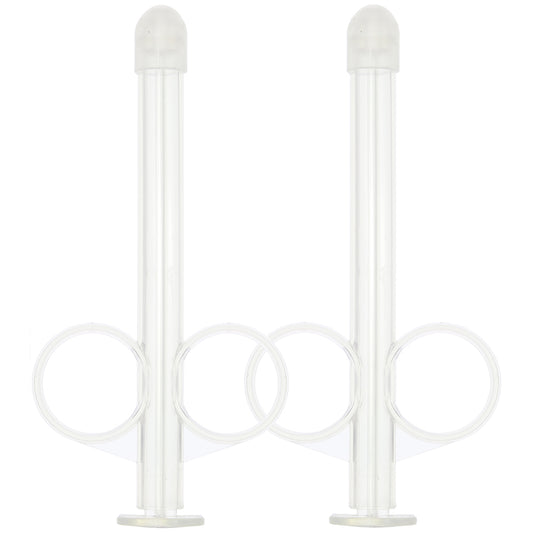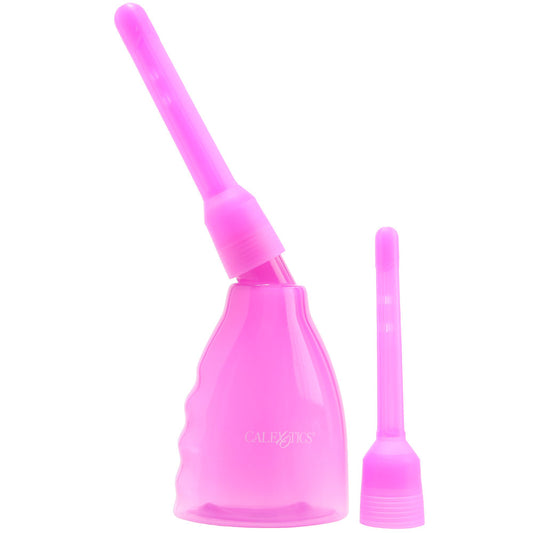
Colonics and enemas. They both involve introducing liquid into the anus, and both are meant to leave the body (the butt, specifically) cleaner than it was beforehand. If you didn’t know better, you might think that these anal douching treatments are the same thing, but they’re actually not. While both a colonic and an enema aim to cleanse the inner anal canal and/or colon with water or other specialized cleansing solution, each process differs in a few key ways.
Today we’re going to talk about enemas and colonics. What they are, how they differ, which to use when, what each one feels like, and how to anal douche safely at home.
What is an enema?
An enema can be done as a do-it-yourself procedure and it aims to clean out the lower colon. You can purchase everything you need for an enema over the counter (OTC) in a pharmacy or online - shops like PinkCherry carry an assortment of douche and enema equipment. There are several reasons one might use an enema: to relieve severe constipation, in preparation for a medical procedure, or when you want to prepare for anal sex play.
When you perform an enema, you are using water or cleansing fluid, introduced via the anus, to flush out the entire colon or rectum. The process itself typically takes less than 15 minutes, though it is advised to stay near a bathroom for a couple of hours to give your body ample opportunity to expel any remaining enema solution.
What is a colonic
A colonic, also known as colonic hydrotherapy or colon irrigation, is a medical procedure that is typically performed by a healthcare professional-- a colonic hygienist or hydrotherapist -- who uses specialized equipment to irrigate the entire colon and clean out a larger portion of the bowel than an enema kit can. Also, as opposed to an enema, which involves infusing an enema solution into the colon once, colonics involve multiple infusions of liquid.
During a colonic, a tube is inserted into the rectum and up to 16 gallons of warm water is pumped into the body. There are two types of colonic “open” and “closed”. The equipment for the procedures varies in shape and size but the major difference is with an open colonic, you decide when to release the bowel’s contents whereas with a “closed” colonic, the technician is in charge of that. There are pros and cons to each type of colonic thus it’s helpful to do a little research before getting one. Whichever method you choose, the procedure typically takes anywhere from 45 minutes to an hour and there can be increased bowel movements within the first few hours afterwards. Additionally, depending on the reason you are getting a colonic, you may be advised to get several over the course of multiple weeks.
When to do enema vs colonic or vice versa
The simplest answer as to when to do an enema vs when to get a colonic is, if you want a fairly straightforward procedure that you can do yourself at home, do an enema. If you want something that goes deeper, is more intense, and is handled by a professional, get a colonic.
Something to keep in mind is that, while cleansing the colon is used to relieve chronic constipation, to prepare for medical procedures like a colonoscopy, or in preparation for anal sex, some folks believe in using enemas or, more often, colonics as a method to “detoxify” the body. The thing is, ‘detoxing’ via a colonic is unnecessary. The bowel and digestive system exist to rid your body of waste matter. If that process isn’t working and you are experiencing severe constipation, it may be worth considering a colonic but if it’s a “detox” you are after, that’s not really a thing.
What do they feel like?
The general answer here, for both colonics and enemas is “weird and possibly slightly uncomfortable but definitely NOT painful”. More specifically, while some of the sensations are similar-- the whole “putting a tube in your anus and introducing water to your colon” thing for example-- there will also be some big differences.
With an enema, after the enema solution is introduced, the stomach and colon might feel a bit “heavy” as they are now full of fluid. You may also experience mild muscle spasms as the muscles of the GI tract work to push whatever is in your colon out. Additionally, with an enema, you need to hang out for a bit (usually a couple of minutes) until you feel the urge to evacuate the bowels and then you can relieve yourself by releasing the contents of the bowels into the toilet.
With a colonic, there can be cramping that is said to be comparable to mild menstrual cramps or cramps one might experience with diarrhea. The cramping will not last the entire colonic cleansing session and can be alleviated with abdominal massage. With what is called a “closed colonic”, the water and waste matter are removed from the body via a tube so you pretty much just hang out while that happens. That said, at the end of the procedure, you will need to use the toilet to make sure everything is out. With an “open colonic” you can release the contents of your bowels when you feel comfortable doing so. Some folks experience fatigue and continued cramping after the colonic cleansing session ends and this usually passes within 24 hours. Additionally, some also find it helpful to stay close to a bathroom in the hours after the procedure, as increased bowel movements can occur.
Which is easier to do yourself?
When it comes to choosing between a colonic vs. enema it is important to remember that only one of those options can be done by yourself at home and that’s the enema. A colonic is a medical procedure that should be performed by a healthcare professional using specialized equipment.
Enemas are designed to be done by yourself, and judging by the sheer amount of easy-to-use enema kit options, a whole lot of folks seem to be doing them in their homes. As long as you are safe, follow instructions clearly, and don’t overdo it, you can --- pretty easily actually -- give yourself an enema at home. If it’s a colonic you want, however, you will have to find a licensed practitioner and go to their establishment to receive the treatment.
So, that’s the story on colonics and enemas, folks! Think you might want to try out an enema at home? Pink Cherry’s got a huge selection of some of the best anal douches. Check out our anal douche and enema products today!

